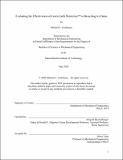| dc.contributor.advisor | Irmgard Bischofberger. | en_US |
| dc.contributor.author | Guillaume, Mitchell L. | en_US |
| dc.contributor.other | Massachusetts Institute of Technology. Department of Mechanical Engineering. | en_US |
| dc.date.accessioned | 2020-11-23T17:40:09Z | |
| dc.date.available | 2020-11-23T17:40:09Z | |
| dc.date.copyright | 2020 | en_US |
| dc.date.issued | 2020 | en_US |
| dc.identifier.uri | https://hdl.handle.net/1721.1/128586 | |
| dc.description | Thesis: S.B., Massachusetts Institute of Technology, Department of Mechanical Engineering, May, 2020 | en_US |
| dc.description | Cataloged from the official PDF of thesis. ""̳" in title on title page appears as superscript TM. | en_US |
| dc.description | Includes bibliographical references (page 16). | en_US |
| dc.description.abstract | Ice dams are a common and destructive problem faced by property owners in climates that experience winter weather. Floe is a startup developing a novel solution to prevent water damage caused by ice dams. The central concept of their product is to use a liquid deicing chemical to cut channels in ice at the roof's edge, allowing water to escape before it can enter the building. Before the product can be brought to market, its efficacy must be proven. To do so, it is necessary to be able to determine if an ice dam has been successfully breached by the deicing fluid without any manual inspection or intervention. To evaluate the merits of different measurement methods, a section of roof is constructed and placed in a cold chamber. A simulated ice dam is formed, and deicing fluid is dispensed. The roof's runoff is collected, and its pH and conductivity are recorded. The mechanics of breaching ice dams are also documented qualitatively. Though pH is a useful indicator of the runoff's concentration of deicing fluid, it is a more sensitive measurement and conductivity may be more reliable. The concentration of deicing fluid in the runoff increases as the ice dam is cut by the deicer. | en_US |
| dc.description.statementofresponsibility | by Mitchell L. Guillaume. | en_US |
| dc.format.extent | 16 pages | en_US |
| dc.language.iso | eng | en_US |
| dc.publisher | Massachusetts Institute of Technology | en_US |
| dc.rights | MIT theses may be protected by copyright. Please reuse MIT thesis content according to the MIT Libraries Permissions Policy, which is available through the URL provided. | en_US |
| dc.rights.uri | http://dspace.mit.edu/handle/1721.1/7582 | en_US |
| dc.subject | Mechanical Engineering. | en_US |
| dc.title | Evaluating the effectiveness of green earth winterizer"̳ in breaching ice dams | en_US |
| dc.type | Thesis | en_US |
| dc.description.degree | S.B. | en_US |
| dc.contributor.department | Massachusetts Institute of Technology. Department of Mechanical Engineering | en_US |
| dc.identifier.oclc | 1201195767 | en_US |
| dc.description.collection | S.B. Massachusetts Institute of Technology, Department of Mechanical Engineering | en_US |
| dspace.imported | 2020-11-23T17:40:07Z | en_US |
| mit.thesis.degree | Bachelor | en_US |
| mit.thesis.department | MechE | en_US |
